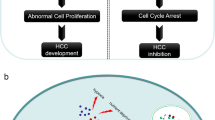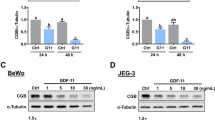Abstract
Transforming growth factor (TGF-β) is associated with the progression of glioblastoma multiforme (GBM)—the most malignant of brain tumors. Since there is a structural homology between TGF-β and human chorionic gonadotropin (hCG) and as both TGF-β and hCG-β are known regulators of oxidative stress and survival responses in a variety of tumors, the role of TGF-β in the regulation of hCG-β and its consequences on redox modulation of glioblastoma cells was investigated. A heightened hCG-β level was observed in GBM tumors. TGF-β treatment increased hCG-β expression in glioma cell lines, and this heightened hCG-β was found to regulate redox homeostasis in TGF-β-treated glioma cells, as siRNA-mediated knockdown of hCG-β (i) elevated reactive oxygen species (ROS) generation, (ii) decreased thioredoxin Trx1 expression and thioredoxin reductase (TrxR) activity, and (iii) abrogated expression of TP53-induced glycolysis and apoptosis regulator (TIGAR). Silencing of hCG-β abrogated Smad2/3 levels, suggesting the existence of TGF-β–hCG-β cross-talk in glioma cells. siRNA-mediated inhibition of elevated TIGAR levels in TGF-β-treated glioma cells was accompanied by an increase in ROS levels. As a farnesyltransferase inhibitor, Manumycin is known to induce glioma cell apoptosis in a ROS-dependent manner, and we investigated whether Manumycin could induce apoptosis in TGF-β-treated cells with elevated hCG-β exhibiting ROS-scavenging property. Manumycin-induced apoptosis in TGF-β-treated cells was accompanied by elevated ROS levels and decreased expression of hCG-β, Trx1, Smad2/3, and TIGAR. These findings indicate the existence of a previously unknown TGF-β–hCG-β link that regulates redox homeostasis in glioma cells.





Similar content being viewed by others
References
Akhurst RJ, Derynck R (2001) TGF-beta signaling in cancer–a double-edged sword. Trends Cell Biol 11:S44–S51
Siegel PM, Massague J (2003) Cytostatic and apoptotic actions of TGF-beta in homeostasis and cancer. Nat Rev Cancer 3:807–821
Massague J, Seoane J, Wotton D (2005) Smad transcription factors. Genes Dev 19:2783–2810
Bruna A, Darken RS, Rojo F, Ocana A, Penuelas S, Arias A, Paris R, Tortosa A, Mora J, Baselga J, Seoane J (2007) High TGFbeta-Smad activity confers poor prognosis in glioma patients and promotes cell proliferation depending on the methylation of the PDGF-B gene. Cancer Cell 11:147–160
Friese MA, Wischhusen J, Wick W, Weiler M, Eisele G, Steinle A, Weller M (2004) RNA interference targeting transforming growth factor-beta enhances NKG2D-mediated antiglioma immune response, inhibits glioma cell migration and invasiveness, and abrogates tumorigenicity in vivo. Cancer Res 64:7596–7603
Penuelas S, Anido J, Prieto-Sanchez RM, Folch G, Barba I, Cuartas I, Garcia-Dorado D, Poca MA, Sahuquillo J, Baselga J, Seoane J (2009) TGF-beta increases glioma-initiating cell self-renewal through the induction of LIF in human glioblastoma. Cancer Cell 15:315–327
Inman GJ, Nicolas FJ, Callahan JF, Harling JD, Gaster LM, Reith AD, Laping NJ, Hill CS (2002) SB-431542 is a potent and specific inhibitor of transforming growth factor-beta superfamily type I activin receptor-like kinase (ALK) receptors ALK4, ALK5, and ALK7. Mol Pharmacol 62:65–74
Hjelmeland MD, Hjelmeland AB, Sathornsumetee S, Reese ED, Herbstreith MH, Laping NJ, Friedman HS, Bigner DD, Wang XF, Rich JN (2004) SB-431542, a small molecule transforming growth factor-beta-receptor antagonist, inhibits human glioma cell line proliferation and motility. Mol Cancer Ther 3:737–745
Tran TT, Uhl M, Ma JY, Janssen L, Sriram V, Aulwurm S, Kerr I, Lam A, Webb HK, Kapoun AM, Kizer DE, McEnroe G, Hart B, Axon J, Murphy A, Chakravarty S, Dugar S, Protter AA, Higgins LS, Wick W, Weller M, Wong DH (2007) Inhibiting TGF-beta signaling restores immune surveillance in the SMA-560 glioma model. Neuro Oncol 9:259–270
Hardee ME, Marciscano AE, Medina-Ramirez CM, Zagzag D, Narayana A, Lonning SM, Barcellos-Hoff MH (2012) Resistance of glioblastoma-initiating cells to radiation mediated by the tumor microenvironment can be abolished by inhibiting transforming growth factor-beta. Cancer Res 72:4119–4129
Sun PD, Davies DR (1995) The cystine-knot growth-factor superfamily. Annu Rev Biophys Biomol Struct 24:269–291
Lapthorn AJ, Harris DC, Littlejohn A, Lustbader JW, Canfield RE, Machin KJ, Morgan FJ, Isaacs NW (1994) Crystal structure of human chorionic gonadotropin. Nature 369:455–461
Sheaff MT, Martin JE, Badenoch DF, Baithun SI (1996) Beta hCG as a prognostic marker in adenocarcinoma of the prostate. J Clin Pathol 49:329–332
Ruddon RW, Bryan AH, Meade-Cobun KS, Pollack VA (1980) Production of human chorionic gonadotropin and its subunits by human tumors growing in nude mice. Cancer Res 40:4007–4012
Huhtaniemi I, Rulli S, Ahtiainen P, Poutanen M (2005) Multiple sites of tumorigenesis in transgenic mice overproducing hCG. Mol Cell Endocrinol 234:117–126
Acevedo HF, Tong JY, Hartsock RJ (1995) Human chorionic gonadotropin-beta subunit gene expression in cultured human fetal and cancer cells of different types and origins. Cancer 76:1467–1475
Iles RK, Delves PJ, Butler SA (2010) Does hCG or hCGbeta play a role in cancer cell biology? Mol Cell Endocrinol 329:62–70
Berndt S, Blacher S, Munaut C, Detilleux J, d’Hauterive SP, Huhtaniemi I, Evain-Brion D, Noel A, Fournier T, Foidart JM (2013) Hyperglycosylated human chorionic gonadotropin stimulates angiogenesis through TGF-beta receptor activation. FASEB J 27:1309–1321
Guo X, Liu G, Schauer IG, Yang G, Mercado-Uribe I, Yang F, Zhang S, He Y, Liu J (2011) Overexpression of the beta subunit of human chorionic gonadotropin promotes the transformation of human ovarian epithelial cells and ovarian tumorigenesis. Am J Pathol 179:1385–1393
Butler SA, Ikram MS, Mathieu S, Iles RK (2000) The increase in bladder carcinoma cell population induced by the free beta subunit of human chorionic gonadotrophin is a result of an anti-apoptosis effect and not cell proliferation. Br J Cancer 82:1553–1556
Jankowska A, Andrusiewicz M, Grabowski J, Nowak-Markwitz E, Warchol JB (2008) Coexpression of human chorionic gonadotropin beta subunit and its receptor in nontrophoblastic gynecological cancer. Int J Gynecol Cancer 18:1102–1107
Bose A, Huhtaniemi I, Singh O, Pal R (2013) Synergistic activation of innate and adaptive immune mechanisms in the treatment of gonadotropin-sensitive tumors. PLoS One 8:e61288
Kajihara T, Uchino S, Suzuki M, Itakura A, Brosens JJ, Ishihara O (2011) Human chorionic gonadotropin confers resistance to oxidative stress-induced apoptosis in decidualizing human endometrial stromal cells. Fertil Steril 95:1302–1307
Overstreet JM, Samarakoon R, Meldrum KK, Higgins PJ (2014) Redox control of p53 in the transcriptional regulation of TGF-beta1 target genes through SMAD cooperativity. Cell Signal 26:1427–1436
Song Y, Keelan J, France JT (1996) Activin-A stimulates, while transforming growth factor beta 1 inhibits, chorionic gonadotrophin production and aromatase activity in cultured human placental trophoblasts. Placenta 17:603–610
Sharma V, Joseph C, Ghosh S, Agarwal A, Mishra MK, Sen E (2007) Kaempferol induces apoptosis in glioblastoma cells through oxidative stress. Mol Cancer Ther 6:2544–2553
Dixit D, Sharma V, Ghosh S, Koul N, Mishra PK, Sen E (2009) Manumycin inhibits STAT3, telomerase activity, and growth of glioma cells by elevating intracellular reactive oxygen species generation. Free Radic Biol Med 47:364–374
Li Z, Li C, Du L, Zhou Y, Wu W (2013) Human chorionic gonadotropin beta induces migration and invasion via activating ERK1/2 and MMP-2 in human prostate cancer DU145 cells. PLoS One 8:e54592
Tewari R, Choudhury SR, Ghosh S, Mehta VS, Sen E (2012) Involvement of TNFalpha-induced TLR4-NF-kappaB and TLR4-HIF-1alpha feed-forward loops in the regulation of inflammatory responses in glioma. J Mol Med (Berl) 90:67–80
Dixit D, Sharma V, Ghosh S, Mehta VS, Sen E (2011) Inhibition of Casein kinase-2 induces p53-dependent cell cycle arrest and sensitizes glioblastoma cells to tumor necrosis factor (TNFalpha)-induced apoptosis through SIRT1 inhibition. Cell Death Dis 3:e271
Dixit D, Ghildiyal R, Anto NP, Sen E (2014) Chaetocin-induced ROS-mediated apoptosis involves ATM-YAP1 axis and JNK-dependent inhibition of glucose metabolism. Cell Death Dis 5:e1212
Szturmowicz M, Slodkowska J, Zych J, Rudzinski P, Sakowicz A, Rowinska-Zakrzewska E (1999) Frequency and clinical significance of beta-subunit human chorionic gonadotropin expression in non-small cell lung cancer patients. Tumour Biol 20:99–104
Bensaad K, Tsuruta A, Selak MA, Vidal MN, Nakano K, Bartrons R, Gottlieb E, Vousden KH (2006) TIGAR, a p53-inducible regulator of glycolysis and apoptosis. Cell 126:107–120
Patel AS, Lin L, Geyer A, Haspel JA, An CH, Cao J, Rosas IO, Morse D (2012) Autophagy in idiopathic pulmonary fibrosis. PLoS One 7:e41394
Ishikawa F, Kaneko E, Sugimoto T, Ishijima T, Wakamatsu M, Yuasa A, Sampei R, Mori K, Nose K, Shibanuma M (2014) A mitochondrial thioredoxin-sensitive mechanism regulates TGF-beta-mediated gene expression associated with epithelial-mesenchymal transition. Biochem Biophys Res Commun 443:821–827
Samarakoon R, Dobberfuhl AD, Cooley C, Overstreet JM, Patel S, Goldschmeding R, Meldrum KK, Higgins PJ (2013) Induction of renal fibrotic genes by TGF-beta1 requires EGFR activation, p53 and reactive oxygen species. Cell Signal 25:2198–2209
Author information
Authors and Affiliations
Corresponding author
Electronic supplementary material
Below is the link to the electronic supplementary material.
11010_2014_2237_MOESM1_ESM.tif
ESM 1 ROS generation in glioma cells treated with TGF-β in the presence or absence of SB431542 as determined by DCFDA staining. Treatment with SB431542 increases ROS generation as determined by DCFDA staining. This is concurrent with the increased mitochondrial localization of ROS. Differential interference contrast (DIC) and immunofluorescence (DCFDA; 10 μM and Mitotracker Red; 100 nM) images showing ROS levels in U87MG glioma cells treated with TGF-β in the presence and absence of SB431542. Images were taken at 40x magnification. Scale bar is representative of 50 µm distance
Rights and permissions
About this article
Cite this article
Ahmad, F., Ghosh, S., Sinha, S. et al. TGF-β-induced hCG-β regulates redox homeostasis in glioma cells. Mol Cell Biochem 399, 105–112 (2015). https://doi.org/10.1007/s11010-014-2237-6
Received:
Accepted:
Published:
Issue Date:
DOI: https://doi.org/10.1007/s11010-014-2237-6




